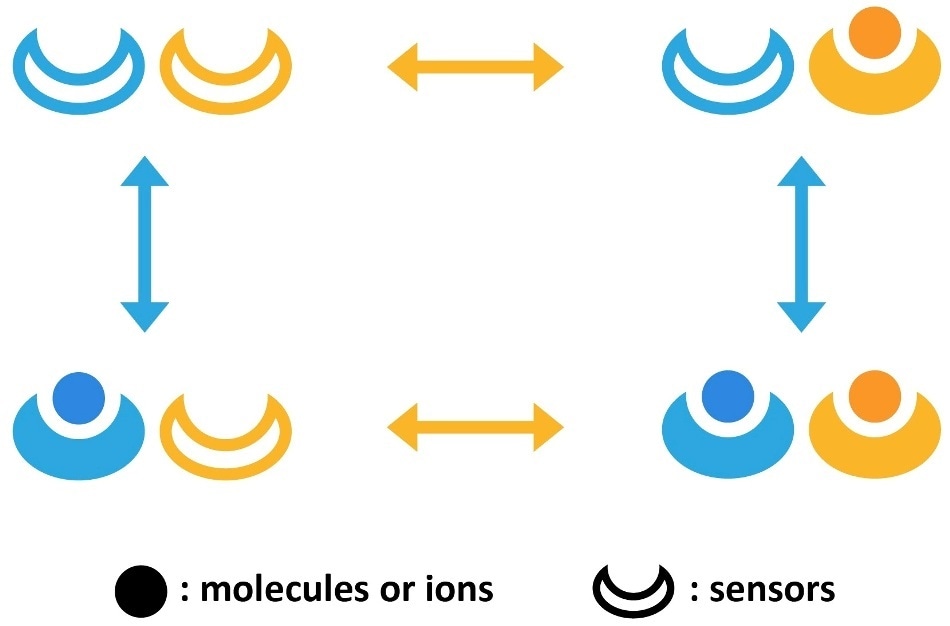The human body's capability to identify foreign material, disease, and the location of food sources and toxins is governed by a mixture of chemicals surrounding the cells and also their ability to “read” these chemicals. This makes cells extremely sensitive.

The model has two information processing units (or sensors), which bind to molecules or ions within the chemical cocktail and change from a bound state to an unbound state, thus allowing the cell to gain information about the outside world. Image Credit: Okinawa Institute of Science and Technology Graduate University (OIST).
The immune system of a person can, in fact, be triggered by the occurrence of a single foreign molecule or ion. However, researchers could not identify how cells achieve such a level of sensitivity.
Recently, researchers from the Biological Physics Theory Unit at Okinawa Institute of Science and Technology Graduate University (OIST) worked in collaboration with scientists from the City University of New York developing a simple model offering some resolution.
Using this model, they have identified the techniques employed by a cell to enhance its sensitivity under various conditions, thus throwing light on the mode of operation of the biochemical networks in ones’ body.
This model takes a complex biological system and abstracts it into a simple, understandable mathematical framework. We can use it to tease apart how cells might choose to spend their energy budget, depending on the world around them and other cells they might be talking to.”
Dr Vudtiwat Ngampruetikorn, Former Postdoctoral Researcher, Okinawa Institute of Science and Technology Graduate University
Ngampruetikorn is also the first author of the paper published in Nature Communications.
The researchers found that their perspective was different from that of biologists by creating a quantitative toolkit for this biological question.
The two disciplines are complimentary to one another. Biologists tend to focus on one area and delve deeply into the details, whereas physicists simplify and look for patterns across entire systems. It’s important that we work closely together to make sure that our quantitative models aren’t too abstract and include the important details.”
Greg Stephens, Professor, Okinawa Institute of Science and Technology Graduate University
Researchers designed a model representing a cell on their computers. The cell included two sensors, or information processing units, which responded to the cell’s exterior environment.
The sensors could be adhered to an ion or molecule from outside, or remain unbound. When there is a change in the number of ions or molecules in a mixture of chemicals outside the cell, the sensors would reach and, based on these changes, they either attach themselves to a new ion or molecule or stay unbound.
This enables the cell to acquire information related to the external world, which permits the researchers to measure the effect on its sensitivity.
Once we had the model, we could test all sorts of questions. For example, is the cell more sensitive if we allow it to consume more energy? Or if we allow the two sensors to cooperate? How does the cell’s prior experiences influence its sensitivity?”
Dr Vudtiwat Ngampruetikorn, Former Postdoctoral Researcher, Okinawa Institute of Science and Technology Graduate University
The researchers analyzed whether enabling the cell to use up energy and permitting the two sensors to interact helped the cell reach a higher level of sensitivity.
They also made decisions to change two other components to check whether it had an effect—the level of noise, that is, the amount of unnecessary information or uncertainty in the mixture of chemicals, and the signal prior, that is, the cell’s acquired knowledge, learned from past experiences.
Earlier studies had revealed that sensor interactions and energy consumption was considered to be the key factors for cell sensitivity. However, this study has discovered that this is not always true.
Under certain circumstances, like if the mixture of chemicals had a lower noise level and the interlink between various chemicals were high, it was found that permitting the cell to consume energy and the sensors to interact helped to reach a higher level of sensitivity. However, in other cases, for instance, if the noise level was higher, this was not the case.
According to Stephens, “It’s like tuning into a radio, if there’s too much static (or noise), it doesn’t do any good to turn up the radio (or, in this case, amplify the signal with energy and interactions).”
Yet, Dr. Ngampruetikorn noted, sensor interactions and energy consumption are considered as crucial mechanisms under several conditions.
“It would be interesting to continue to use this model to determine exactly how energy consumption can influence a cell’s sensitivity,” he said. “And in what situations it’s most valuable,” added Dr. Ngampruetikorn.
The researchers actually preferred the observation of how cells respond to their surroundings, but they reiterated that the general framework of their model could be applied to unravel the sensing strategies across the biological world.
According to Professor Stephens, while considerable efforts are being taken to characterize isolated, individual systems, very little work has gone into looking for common principles.
Stephens added, “If we can find these principles, then it could renew our understanding of how living systems function, from cell communication and the brain, to animal behavior and social interactions.”
Source:
Journal reference:
Ngampruetikorn, V., et al. (2020) Energy consumption and cooperation for optimal sensing. Nature Communications. doi.org/10.1038/s41467-020-14806-y.